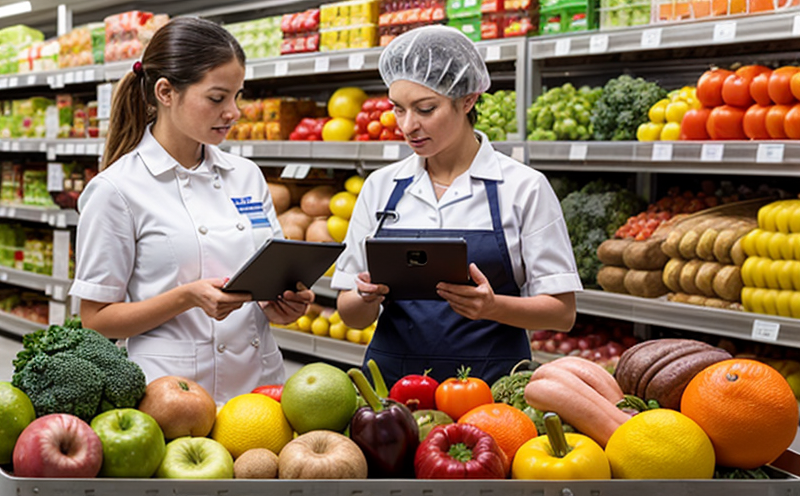Food Safety and Supply Chain Management: A Critical Examination
The food industry is a complex web of production, processing, transportation, and distribution that requires stringent safety measures to ensure the quality and integrity of products reaching consumers. Food safety has become a critical concern in recent years due to increasing awareness about the risks associated with contaminated or spoiled food products. Supply chain management plays a pivotal role in ensuring that food products are handled, stored, and transported safely throughout their lifecycle.
The Importance of Food Safety
Food safety is not just an essential aspect of public health; it also has significant economic implications for businesses involved in the food industry. According to the World Health Organization (WHO), approximately 1 in 10 people fall ill every year from eating contaminated or spoiled food, resulting in over 400,000 deaths worldwide. These statistics underscore the gravity of the issue and emphasize the need for robust measures to prevent contamination and ensure safe production practices.
Common Food Safety Hazards
Microbial Contamination: Bacteria like Salmonella, E. coli, and Listeria can cause foodborne illnesses. These pathogens can be introduced at any stage of the supply chain, from farms to processing facilities.
Chemical Contamination: Pesticide residues, heavy metals, and other chemicals can contaminate food products during production or transportation.
Physical Hazards: Foreign objects like glass shards, metal fragments, or pests can cause physical harm to consumers if not detected early enough.
Prevention Measures
Farm-to-Table Approach: Implementing robust farm-to-table practices, such as regular inspections and monitoring of soil quality, water usage, and animal health, can reduce the risk of contamination at the source.
Food Processing Regulations: Adhering to food processing regulations, including proper cooking and storage procedures, can minimize the risk of cross-contamination during processing.
Supply Chain Management
Effective supply chain management is critical in ensuring that food products are handled, stored, and transported safely throughout their lifecycle. A well-managed supply chain should have multiple layers of protection, including:
Source Verification: Verifying the authenticity of ingredients and raw materials to prevent substitution or adulteration.
Regular Audits and Inspections: Conducting regular audits and inspections at farms, processing facilities, and transportation hubs to identify potential risks.
Temperature Control: Maintaining optimal temperature ranges during storage and transportation to prevent spoilage and contamination.
Documented Procedures: Establishing clear procedures for tracking food products through the supply chain, including documentation of handling, storage, and transportation activities.
The Role of Technology in Food Safety
Technology is increasingly being leveraged to enhance food safety. Some examples include:
Blockchain Technology: Utilizing blockchain technology to create tamper-evident records of food product movement throughout the supply chain.
Sensors and Monitoring Systems: Deploying sensors and monitoring systems to track temperature, humidity, and other environmental factors that can impact food quality.
Artificial Intelligence (AI) and Machine Learning (ML): Applying AI and ML algorithms to analyze data from various sources, identify potential risks, and predict the likelihood of contamination.
Challenges and Opportunities
Implementing robust food safety measures is an ongoing challenge for businesses in the food industry. Some common challenges include:
Cost: Implementing comprehensive food safety measures can be costly, making it challenging for small businesses to comply.
Regulatory Complexity: Food safety regulations vary across jurisdictions, creating complexity and confusion for businesses operating globally.
Despite these challenges, there are also opportunities to innovate and improve food safety practices. Some areas of focus include:
Sustainability: Developing sustainable production practices that prioritize environmental stewardship while maintaining high food safety standards.
Digital Transformation: Leveraging digital technologies to enhance supply chain visibility, improve data collection and analysis, and streamline compliance.
QA
Q: What are the most common causes of foodborne illnesses?
A: The most common causes of foodborne illnesses include microbial contamination (bacteria like Salmonella and E. coli), chemical contamination (pesticides and heavy metals), and physical hazards (foreign objects).
Q: How can businesses reduce the risk of contamination in their supply chain?
A: Businesses can reduce the risk of contamination by implementing robust farm-to-table practices, adhering to food processing regulations, conducting regular audits and inspections, maintaining temperature control, and establishing clear procedures for tracking food products through the supply chain.
Q: What role does technology play in enhancing food safety?
A: Technology plays a significant role in enhancing food safety by enabling the use of blockchain, sensors, and monitoring systems to track temperature, humidity, and other environmental factors that can impact food quality. AI and ML algorithms can also be applied to analyze data from various sources, identify potential risks, and predict the likelihood of contamination.
Q: What are some common challenges in implementing comprehensive food safety measures?
A: Common challenges include high costs, regulatory complexity, and difficulty in maintaining supply chain visibility across global operations.
Q: How can businesses prioritize sustainability while maintaining high food safety standards?
A: Businesses can prioritize sustainability by developing sustainable production practices that focus on environmental stewardship. This may involve reducing water usage, minimizing waste, and promoting eco-friendly packaging options.
Q: What are some emerging trends in food safety technology?
A: Emerging trends include the use of AI-powered predictive analytics to identify potential risks, implementation of blockchain-based tracking systems for supply chain management, and development of sensor-enabled monitoring systems for real-time temperature control.

































